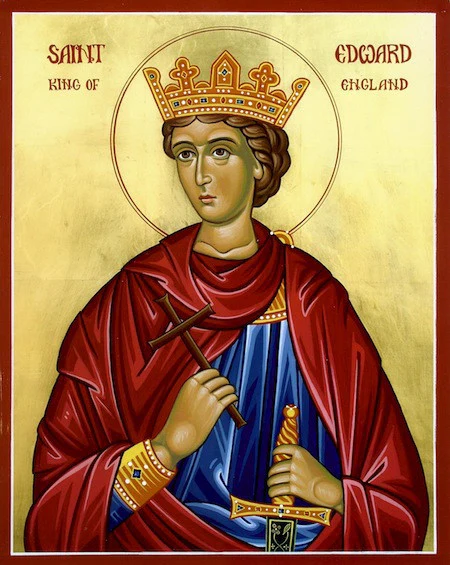



King Edward The Martyr – Quick Stats




Born: c. 962 AD
King Edward the Martyr: A Legacy of Faith and Betrayal
King Edward the Martyr, one of the lesser-known monarchs of Anglo-Saxon England, ruled for a brief and turbulent period between 975 and 978 AD. His reign was marked by political instability, religious disputes, and a tragic assassination that left his legacy shrouded in mystery. Despite his short reign, Edward's life and death had a significant impact on the subsequent history of England, influencing both the monarchy and the Church.
Early Life and Background
Edward was born around 962 AD, the eldest son of King Edgar the Peaceful and his first wife, Æthelflæd. His father, King Edgar, had successfully consolidated power across England, earning a reputation as a strong and unifying ruler. However, Edward's birth was marred by controversy, as his mother died shortly after his birth, and his legitimacy was questioned by some factions of the nobility.
Edward was born around 962 AD, the eldest son of King Edgar the Peaceful and his first wife, Æthelflæd. His father, King Edgar, had successfully consolidated power across England, earning a reputation as a strong and unifying ruler. However, Edward's birth was marred by controversy, as his mother died shortly after his birth, and his legitimacy was questioned by some factions of the nobility.
Following Edgar's death in 975 AD, a succession crisis emerged. Edward, as the eldest son, was the natural heir, but his young age and perceived lack of experience made him a controversial choice. His stepmother, Queen Ælfthryth, pushed for her own son, Æthelred, to take the throne instead. This rivalry set the stage for a power struggle that would define Edward's brief reign.
Accession to the Throne
Edward ascended to the throne in 975 AD at approximately 13 years old. His coronation was supported by influential figures such as Dunstan, the Archbishop of Canterbury, and Oswald of Worcester, both of whom were key proponents of monastic reform.
Edward ascended to the throne in 975 AD at approximately 13 years old. His coronation was supported by influential figures such as Dunstan, the Archbishop of Canterbury, and Oswald of Worcester, both of whom were key proponents of monastic reform.
Edward's reign coincided with a period of religious tension in England. The monastic reform movement, led by figures like Dunstan, sought to impose stricter rules on monasteries and increase their influence in secular affairs. However, many nobles resisted these changes, fearing a loss of power and autonomy. This divide created a volatile political environment that Edward struggled to navigate.
According to some reports, Edward had ridden alone to Corfe Castle, where he was received by Queen Ælfthryth. While dismounting from his horse, he was offered a drink. As he reached for it, he was stabbed by one or more individuals, possibly acting under the orders of Ælfthryth herself. Bleeding heavily, Edward tried to ride away but collapsed and died.
The murder of Edward shocked the kingdom. His body was initially discarded without ceremony, highlighting the brutality of his death. However, supporters of Edward, particularly those aligned with the monastic reform movement, soon recovered his body and buried him at Wareham with respect. The haste and secrecy surrounding his burial further fueled suspicions of foul play.
In the years following Edward's death, stories of miracles began to emerge at his burial site. These miracles contributed to Edward's growing reputation as a martyr who had died for a just cause. His death became a symbol of the triumph of worldly ambition over spiritual values, further cementing his place in the religious consciousness of medieval England.
Legacy and Canonization
Following his death, Edward was buried at Wareham, but his body was later exhumed and reinterred at Shaftesbury Abbey. Reports of miraculous healings at his tomb contributed to his growing reputation as a saint. In 1001 AD, Edward was officially canonized by the Church, and he became known as Saint Edward the Martyr.
Following his death, Edward was buried at Wareham, but his body was later exhumed and reinterred at Shaftesbury Abbey. Reports of miraculous healings at his tomb contributed to his growing reputation as a saint. In 1001 AD, Edward was officially canonized by the Church, and he became known as Saint Edward the Martyr.
Conclusion
King Edward the Martyr's brief reign and tragic death left a lasting impact on English history. His life highlights the challenges faced by young monarchs in a politically unstable environment, while his martyrdom underscores the significant role of the Church in shaping historical narratives. Despite the controversies surrounding his reign, Edward's legacy as a saint and martyr continues to be remembered as a symbol of piety and moral integrity in the face of political intrigue.
King Edward the Martyr's brief reign and tragic death left a lasting impact on English history. His life highlights the challenges faced by young monarchs in a politically unstable environment, while his martyrdom underscores the significant role of the Church in shaping historical narratives. Despite the controversies surrounding his reign, Edward's legacy as a saint and martyr continues to be remembered as a symbol of piety and moral integrity in the face of political intrigue.
Political Challenges and Reign
Edward's reign was marked by continuous power struggles between two main factions: the supporters of monastic reform, led by Dunstan, and the anti-reformist nobles. These disputes often escalated into local conflicts, undermining Edward's authority.
Edward's reign was marked by continuous power struggles between two main factions: the supporters of monastic reform, led by Dunstan, and the anti-reformist nobles. These disputes often escalated into local conflicts, undermining Edward's authority.
One of the significant challenges Edward faced was the redistribution of lands that had previously been granted to monasteries. Many secular nobles had taken control of these lands during King Edgar's reign and were reluctant to return them. Edward's attempts to enforce the return of monastic lands alienated powerful members of the nobility, further weakening his position.
Despite these challenges, Edward's supporters praised his piety and commitment to justice. He was seen as a devout king who sought to uphold the moral and religious values of his time, even at great personal risk.
The Assassination of Edward
Edward's reign came to a tragic and abrupt end on March 18, 978 AD. While visiting his half-brother Æthelred and stepmother Ælfthryth at Corfe Castle in Dorset, Edward was murdered. The exact circumstances of his death remain unclear, but contemporary accounts suggest he was ambushed and stabbed to death by members of the household.
Edward's reign came to a tragic and abrupt end on March 18, 978 AD. While visiting his half-brother Æthelred and stepmother Ælfthryth at Corfe Castle in Dorset, Edward was murdered. The exact circumstances of his death remain unclear, but contemporary accounts suggest he was ambushed and stabbed to death by members of the household.
In modern times, Edward's legacy is less well-known, but his story remains a compelling example of the complex interplay between politics, religion, and personal ambition in early medieval England.
Cultural and Religious Impact
Edward's cult as a martyr king grew steadily throughout the medieval period. His feast day, March 18, was celebrated with religious ceremonies, and his relics were venerated by pilgrims. The cult of Saint Edward the Martyr played a role in reinforcing the legitimacy of the monarchy and the close ties between the Crown and the Church.
Edward's cult as a martyr king grew steadily throughout the medieval period. His feast day, March 18, was celebrated with religious ceremonies, and his relics were venerated by pilgrims. The cult of Saint Edward the Martyr played a role in reinforcing the legitimacy of the monarchy and the close ties between the Crown and the Church.
Edward's assassination also had significant political ramifications. The ascension of Æthelred the Unready, his half-brother, led to a period of instability and Viking invasions that plagued England for decades. The memory of Edward's martyrdom served as a reminder of the dangers of political intrigue and the importance of moral leadership.
Historical Interpretations
The story of King Edward the Martyr has been interpreted in various ways over the centuries. Some historians view him as a tragic figure, a young and inexperienced king caught in the crossfire of political and religious disputes. Others see him as a symbol of piety and moral integrity, whose death represented the triumph of worldly ambition over spiritual values.
The story of King Edward the Martyr has been interpreted in various ways over the centuries. Some historians view him as a tragic figure, a young and inexperienced king caught in the crossfire of political and religious disputes. Others see him as a symbol of piety and moral integrity, whose death represented the triumph of worldly ambition over spiritual values.
Edward's canonization helped solidify his legacy as a holy and righteous king who had been betrayed by his own family. His veneration as a saint reflected the deeply religious nature of Anglo-Saxon society and the importance of the Church in shaping historical narratives.
Successor: Aethelred II The Unready
Predecessor: King Edgar The Peaceful
Children: None
Wife: None
Father: King Edgar The Peaceful
Mother: Ætheflaed
Died: 18 March 978 AD


Many historians believe that Queen Ælfthryth orchestrated the assassination to secure the throne for her son, Æthelred. Her involvement, however, remains speculative due to the lack of concrete evidence. What is clear is that Edward’s death was politically motivated, stemming from ongoing disputes over succession and power.
Corfe Castle Dorset where King Edward The Martyr was Murdered


